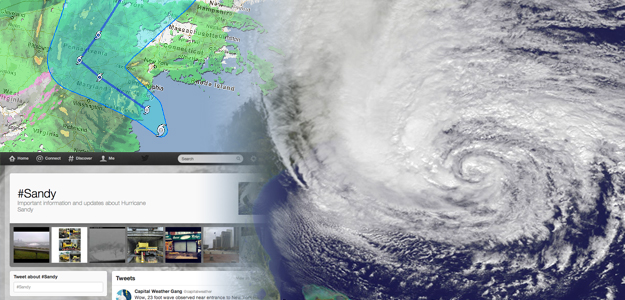 As I sat at my desk Monday afternoon, the tree out my window bent at an impossible angle, tested by the indomitable tendrils of Hurricane Sandy. I witnessed a large, black bird being blown sideways through the air in a very non-bird-like fashion. I counted down the minutes until a wayward wheelbarrow would almost certainly come barreling through my living room. All this, despite the fact that I was in my land-locked home, two hours north of New York City, and far from the wrathiest parts of Sandy’s wrath.
As I sat at my desk Monday afternoon, the tree out my window bent at an impossible angle, tested by the indomitable tendrils of Hurricane Sandy. I witnessed a large, black bird being blown sideways through the air in a very non-bird-like fashion. I counted down the minutes until a wayward wheelbarrow would almost certainly come barreling through my living room. All this, despite the fact that I was in my land-locked home, two hours north of New York City, and far from the wrathiest parts of Sandy’s wrath.
South of me, the scene was far more grim. Tens of thousands lost power, a fate that awaited millions more in the hours to come. Roads closed. Entire towns drowned. Lower Manhattan flooded. Families — mine included — fled for their lives, kids and pets and vital tax documents in tow, for higher, drier, better-fortified ground.
Of course, I know all this because, like many of you, I spent much of Monday reading every tidbit of news, watching every eyewitness video, viewing every Instagram photo I could find of Sandy’s path of destruction. I’d become obsessive, unable to complete a single task without interrupting myself with #Sandy tweets, and Facebook status updates, and an endless stream of blog posts. All the while, the tempest’s roar droned on around me.
For far too long, I prided myself as something of a romantic luddite (as if there’s any other type), someone who waxed nostalgia on the simpler times, when our minds were free of the tenacious bombardment of information that defines our connected age. Through these black-and-white-colored glasses, the Web looked to me like a non-essential tool, something the human race — if not myself, whose livelihood relies on a solid Internet connection — could do without.
Even Sunday night, as the impending severity of Sandy became more clear, I found myself fantasizing about losing power. Perhaps I would hunker down with my dog and read a book by candle light, I daydreamed. Maybe I would just sit on the couch, in the dark, drink whisky, and get lost in my own head. Who needs all that chatter? Not me, I thought. I’d be better off without, at least for a day or two. Some forced disconnection would do me some good.
Then came Monday. As the winds of Sandy picked up, I found myself increasingly glued to the Web. And sometime around 3pm, it hit me: I would be completely and thoroughly screwed without it. More than heat, more than refrigeration, more than running hot water — I needed an Internet connection to outlast this blasted storm.
Online news about Sandy was not simply mindless drivel, but crucial information that could potentially save my life and the life of my family, some of whom were stranded gravely close to the waters of Long Island and needed to know as much about the storm as they could. Twitter, so often used for the purposes of self-promotion and meme spreading, transformed into vital public utility that provided real-time data about the danger outdoors. And Facebook, a site I generally viewed as some horrible joke on the notion of friendship, became my go-to place to quickly and easily let all of my loved-ones know I was OK, and to make sure they were OK too.
I fully realize that the previous paragraph may come across as though it were written by a bumbling Neanderthal just thawed from some neolithic block of ice — not a 29-year-old technology journalist who has spent more than two-thirds of his life online. And my only rebuttal to that is: I am a skeptic. And because of that, it has taken me this long to accept the worth of the Web, not just its powers of distraction.
Believe it or not, there are many people out there still on the far side of the fence. According to the Federal Communications Commission, approximately 100 million Americans who have access to high-speed Internet do not subscribe to the service. Many of these people presumably are unable to afford it. Others, like my next-door neighbors — all of whom are in their 20s — simply don’t care. They don’t even have dial-up! Why? I asked them once. Well, because they didn’t need it. At the time, it seemed to me a reasonable — even honorable — answer.
No more. The peril that imposed itself on much of the East Coast on Monday has converted me into an acolyte for the Web, a believer in the conclusion that an Internet connection is a vital utility, not merely something to keep us entertained or overly informed — an idea desperate people discovered long ago.
As the sun began to fall behind the Catskill mountains outside my window Monday evening, and Sandy rumbled across the darkening landscape, I basked in my newfound state of mind — a wisdom of the current human existence. But above all else, I hoped that the power lines stayed intact — not simply so my food wouldn’t spoil, or so I could take a hot shower in the morning, but because, when I woke up, I would need a way to make sure everyone I care about made it through the night unharmed.


